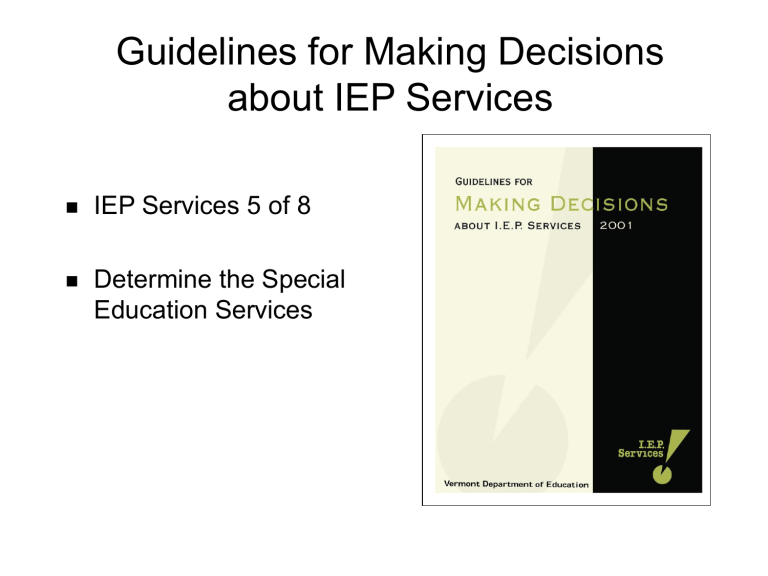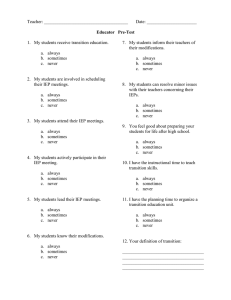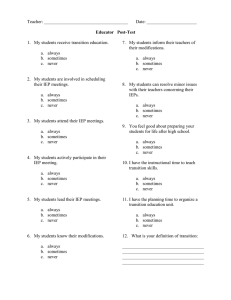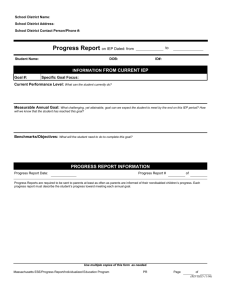Guidelines for Making Decisions about IEP Services IEP Services 5 of 8

Guidelines for Making Decisions about IEP Services
IEP Services 5 of 8
Determine the Special
Education Services
This series of slide shows is based on:
Guidelines for Making
Decisions about IEP Services
2001
Michael F. Giangreco, Ph.D.
University of Vermont, Center on Disability and Community Inclusion
This document is available in a pdf (portable document format) on the internet http://www.uvm.edu/~uapvt/iepservices/ http://www.state.vt.us/educ/Cses/sped/main.htm
Distributed by the
Vermont Department of Education
Family and Educational Support Team
Montpelier, Vermont
Development of this material was supported by a grant from the Vermont Department of Education, Montpelier,
Vermont under the auspices of Vermont Act 117: An Act to Strengthen the Capacity of Vermont’s Education
System to Meet the Needs of All Students, Section 7 (d) (5).
Make Special Education
Decisions Based on
Student’s Needs and
Educational Priorities
The IEP team must first determine the type and extent of special education services that will be provided for the student.
These decisions should be described on the IEP clearly and simply.
For some students, providing special education services is sufficient to ensure a free appropriate public education, without the need for related services.
Not all individually determined supports are considered “special education”
Supports should be documented as “special education” only when the intensity, frequency, or combination of supports reaches a level that the IEP team agrees extends beyond what is provided by the classroom teacher, the
Educational Support System, or a Section 504 Plan.
Consider the types of special education supports a student could receive...
Changes in Curriculum
Adaptations to the
Delivery of Instruction
Different Instructional
Methods
Examples of Changes in Curriculum
teaching a smaller number of objectives from the general education curriculum at grade-level
teaching general education curriculum outside grade-level
teaching functional life skills that typically are not included in the general education curriculum
Examples of Adaptations to the
Delivery of Instruction
equipment or materials to address sensory or orthopedic needs (e.g., FM system, positioning devices)
communication accommodations (e.g., American Sign
Language, augmentative/alternative communication device)
behavioral accommodations (e.g., positive behavior support plan, crisis management plan)
Examples of
Different Instructional Methods
pre-teaching of in-class lessons extended time for responding or completion systematic instructional methods beyond those typically used in the classroom specific cueing or prompting strategies
time delay procedures errorless learning task analysis and chaining techniques repeated practice individualized correction or reinforcement computer-assisted learning materials
Questions to consider when making decisions about special education...
Does the student require ongoing changes to the content or scope of the general education curriculum
(e.g., less or more content at grade-level, content at a different grade-level)?
Does the student benefit from typical instructional approaches used in the regular classroom?
What other instructional methods have worked well for this student in the past?
What adaptations to the delivery of instruction does the student need to pursue his or her IEP goals or identified parts of the general education curriculum?
Do proposed adaptations to the delivery of instruction or instructional methods help the student “fit in” and be a member of the classroom or might they cause the student standout in negative or stigmatizing ways?
Did the IEP team consider transition services, as appropriate, depending on the age of the student?
Does the frequency, intensity, or combination of services being suggested as “special education” extend beyond what is reasonably provided through the general education classroom program, Educational
Support System, or a
Section 504 plan ?
Once the type of special education supports have been agreed to, the team needs to determine:
(a) How much time will it take to prepare for, and implement, the agreed upon supports?
(b) Which team members will be responsible for planning for and implementing the agreed upon supports?
(c) What kinds of information will the team collect to determine if the supports have been successful?
For example, it may NOT be special education if all a student needs to be successful is a few of the following supports.
an extra study hall
more opportunities for practice
extended time to complete tests
modified homework assignments
a special pencil grip
large print materials.
Open the next slide show
Open the next slide show labeled:
IEP Services 6 of 8
Slide show 6 of 8 addresses, Some Students with IEPs May Need
Related Services





